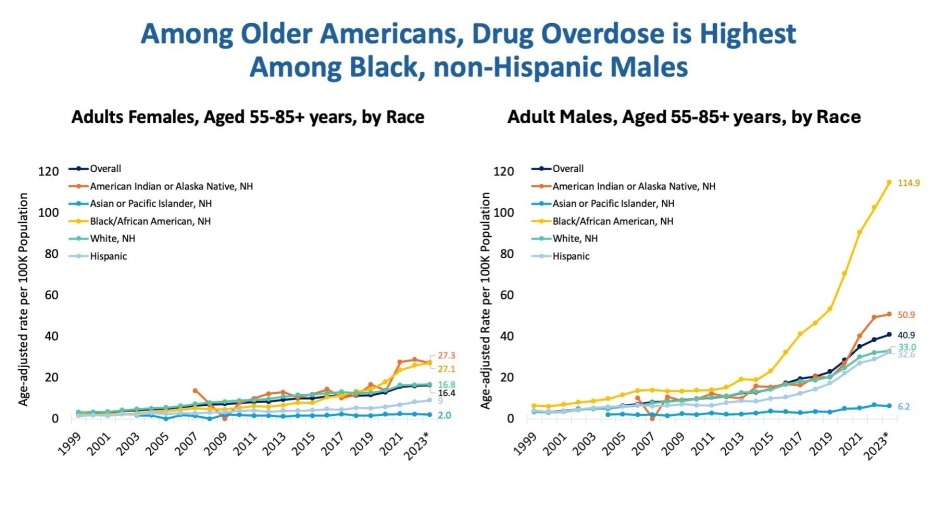
Saturday, August 31, is International Overdose Awareness Day, when we collectively remember those who have lost their lives to drug overdose, support those who grieve those losses, and offer encouragement to those who seek recovery from addiction. It is also an opportunity to share new knowledge about the overdose crisis and strategies for confronting it. There is some very good news this year: Provisional data from the CDC show that, overall, overdose deaths dropped by 7.5% in the 12 months ending March, 2024, the largest decline in decades. It is cause for optimism. But unfortunately, for some groups, we continue to see only greater escalation of the overdose crisis.
A recent New York Times article highlighted the tragic epidemic of overdose deaths among older Black men in Baltimore. It is a city that has been especially hard-hit by the overdose crisis, but the trend is being seen nationwide. Although white and Black people use drugs at similar rates, fatal overdoses have escalated in Black people at a much higher rate than in other groups over the past decade, and multiple recent studies have documented especially high rates of overdose deaths among older Black men.
Fentanyl, often in combination with stimulants, is driving increased overdose deaths in most demographic groups. In all groups, men are at greater risk of overdose than women, but additional factors, including age-related health disparities, social isolation, and lifetime exposure to structural racism, may be colliding to produce the rise in overdoses among older Black men especially, and it points to the urgent need for intervention.
A NIDA analysis found that between 2015 and 2023 (provisional data), there was a nearly 5-fold increase in overdose deaths among non-Hispanic Black men 55 and older (figure). In 2023, deaths in that demographic category were nearly triple the national average for that age group. The largest proportion of these deaths, and the steepest increases, involved fentanyl and cocaine. The overdose rate in older Black men is markedly higher than that for Black men overall.
An increase in drug use and drug problems is being seen in older people of all races and ethnicities. Over the past two decades, substance use treatment admissions have increased among people aged 50 and over. In older adults, the risk of problematic opioid use is raised by chronic illness, and pain may be an especially important factor. Chronic pain is prevalent among older adults, and treatment for pain is less effective in this age group than it is in younger people; it negatively impacts quality of life and is a risk factor for cognitive decline and premature death.
As people age, they may start to lose partners and social contacts. A recent National Academies report identified social isolation as a major contributing factor to illness and poor quality of life in older people; it particularly impacts men, who tend to have fewer social supports in later life than women. Loneliness and social isolation are well-known risk factors for substance use, and in an analysis of substance use patterns among older people with varying degrees of social connectedness and perceived loneliness, those who lived alone and felt lonely had the highest rates of nonmedical drug use. Although Black and Hispanic older adults have lower odds of social isolation than white older adults, as well as lower rates of alcohol use, one analysis of overdose deaths among middle-aged and older adults in Illinois identified a common profile of socially isolated, predominantly Black men who had alcohol in their system when they died.
Health and other social disparities likely contribute to escalating overdose rates among older Black men. Black people face discrimination and implicit bias in healthcare settings, including significantly longer wait times for emergency treatment of health problems. Black patients tend to be undertreated for pain, compared to white patients. Such discrimination goes along with other social determinants of health including under-resourced urban environments, housing instability, and food insecurity that may contribute to higher rates of premature mortality and a higher burden of chronic illnesses. Excess mortality from causes including heart disease, cancer, assault, cerebrovascular disease, and diabetes is also higher among Black men.
Discrimination takes a toll on mental health. An analysis of data from the National Epidemiologic Survey on Alcohol and Related Conditions found that discrimination against Black people was associated with higher odds of illicit drug use. Along with other minoritized groups like American Indians, Black people are less likely than white people to engage or remain in substance use treatment. Black people seeking addiction treatment face greater delays obtaining it than white people, and they are much less likely than white patients to be prescribed buprenorphine, which significantly reduces the risk of overdose death. Unfortunately, even when older Black people receive substance use treatment, they are more likely than their white counterparts to have their treatment terminated by a treatment facility.
Structural discrimination is nothing new. The greater devastation fentanyl is wreaking in Black neighborhoods and communities like Baltimore could partly reflect longstanding patterns of economic disadvantage and mental health impacts of adversity—a reemerging signal that had been temporarily drowned out by the white overdose deaths that dominated the statistics and the headlines during the first two decades of the opioid epidemic. Overdose death rates among older black men have been consistently higher than for any other racial/ethnic group of the same age and have accelerated just as fast if not faster than in other groups for nearly a decade.
In a widely cited 2015 paper, Princeton economists Anne Case and Angus Deaton argued that increased economic hardships for white people without college education in the years 1999-2013 contributed to increased mortality in this group from drug overdose, suicide, and alcohol-related liver disease—what came to be called “deaths of despair.” However, economic disadvantage has long been the reality for minoritized groups whose higher risks of addiction and its consequences were invisible or ignored. Until 2001, deaths from overdose among Black people were consistently much higher than in white people, yet in that era, the drug problem in Black communities was framed as a problem of crime and deviance, not legitimized through a lens like despair. Overdose rates among Black people again surpassed those for white people in 2020.
The tragic situation the New York Times highlighted in Baltimore appears to be a nationwide problem, and it is clearly a complex one with many intersecting factors at play. Research alone cannot solve it, but it is necessary to understand why the current dangerous illicit drug supply is disproportionately affecting this population. Is there more to it than the additive risk factors of being male, Black, and older? We also need to understand how the increased burden of potentially co-occurring health conditions, including pain, may affect overdose risk in this group, as well as how their opioid use may intersect with other substance use. Answering these questions can guide the development and implementation of prevention, treatment, and harm-reduction strategies tailored for these communities.
Historically, prevention research has mainly focused on children, adolescents, and young adults, but along with the rise in opioid-related overdoses in older individuals in most racial and ethnic groups, increased use of other drugs like cannabis in older adults highlights the need for different kinds of interventions. This could include interventions to prevent opioid misuse or the transition from use to misuse specifically in older adults taking opioids for chronic pain. It might also include public-health interventions aimed at addressing social isolation and loneliness in older people, which could have benefits for a wide range of physical and mental health outcomes beyond substance use and its consequences.
Understanding structural factors affecting the health of underserved groups, both in the healthcare system and communities, is a primary objective of research that NIDA is funding as part of its Racial Equity Initiative. This research can help illuminate barriers to accessing substance use services in Black communities and inform the development of approaches to overcome them.
NIDA’s Intramural Research Program (IRP), which is located in Baltimore, is already leading several outreach and community-based research initiatives aimed at both better understanding and preventing fatal overdose in the city. For example, along with the Maryland Center for Health Equity at the University of Maryland School of Public Health, NIDA’s IRP is partnering with community barbershops to offer overdose education and naloxone distribution in settings frequented and trusted by Black clients. Analysis of hair samples swept from the floors of these barbershops is being used to monitor the levels of fentanyl in these Baltimore neighborhoods in a completely anonymous manner—a novel approach that could inform how interventions are targeted in these communities.
Ending the overdose epidemic, especially for the hardest-hit groups like older Black men, will not be easy. It will require coordinated work involving health service providers, community coalitions, policy makers, and—critically—people with lived and living experience of substance use. Researchers, too, will be essential, both for developing new and improved interventions and demonstrating how they can be effectively deployed so that they reach the people who need them.
Dr. Nora Volkow, Director
Here I highlight important work being done at NIDA and other news related to the science of drug use and addiction.





